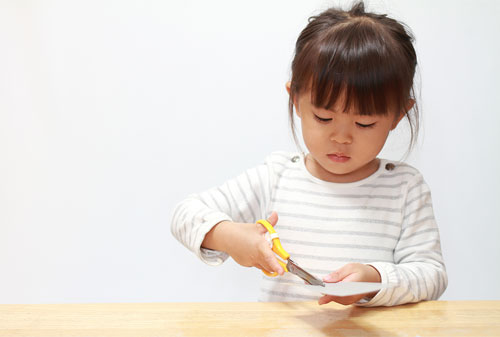




It is important to understand what is meant by accidents, incidents, emergencies and health and safety hazards in home-based childcare.
An emergency is a situation that poses an immediate risk to health, life, property, or environment.
An accident is usually an unplanned, uncontrolled event which leads to an injury.
An incident is usually unplanned and uncontrolled but more often than not does not lead to injury. Sometimes these are classed as near misses.
A hazard is anything that may cause harm, such as chemicals, electricity, playing at a height, an open drawer etc.
The risk is the chance, high or low, that somebody could be harmed by these and other hazards, together with an indication of how serious the harm could be.
Mae'n bwysig deall beth yw ystyr damweiniau, digwyddiadau, argyfyngau a pheryglon iechyd a diogelwch ym maes gofal plant yn y cartref.
Mae argyfwng yn sefyllfa sy'n peri risg uniongyrchol i iechyd, bywyd, eiddo neu'r amgylchedd.
Mae damwain fel arfer yn ddigwyddiad heb ei gynllunio, heb ei reoli sy'n arwain at anaf.
Nid yw digwyddiad fel arfer wedi'i gynllunio na'i reoli ond yn amlach na pheidio, ni fydd yn arwain at anaf. Weithiau, caiff y rhain eu galw yn ddigwyddiadau y bu bron iddynt ddigwydd.
Perygl yw unrhyw beth a allai achosi niwed, fel cemegau, trydan, chwarae ar uchder, drôr agored ac ati.
Risg yw'r siawns, uchel neu isel, y gallai rhywun gael ei niweidio gan y rhain a pheryglon eraill, ynghyd ag awgrym o ba mor ddifrifol y gallai'r niwed hwnnw fod.

It is important to understand the types of accidents, incidents, emergencies and health and safety hazards that may occur in home-based childcare.
| Accident | Incident | Emergency | Hazard |
|---|---|---|---|
| Child falls over toy car in garden and cuts knee. | Child is not collected. | Child has a severe allergic reaction to a bee sting. | Window blind cords within a child’s reach. |
| An 18 month old hits another child on the head with a book leaving small mark. | Garden fence blows down in garden and makes garden unsecure. | Child is knocked down by car. | Broken climbing frame in garden. |
| Child cuts finger on scissors. | Another adult at local toddler group narrowly avoids scalding child in your care with hot tea. | Child is choking. | Garden pond. |
| Child is poked in the eye by stick in garden and sustains minor injury. | Outbreak of infectious disease in setting. | Child falls down stairs and is unconscious. | Kitchen cleaning chemicals. |
Mae'n bwysig deall y mathau o ddamweiniau, digwyddiadau, argyfyngau a pheryglon iechyd a diogelwch a fyddai'n gallu digwydd mewn gofal plant yn y cartref.
| Damwain | Digwyddiad | Argyfwng | Peryg |
|---|---|---|---|
| Mae plentyn yn baglu dros gar tegan yn yr ardd ac yn cael cwt ar ei ben-lin. | Ni chaiff plentyn ei gasglu. | Mae plentyn yn cael adwaith alergaidd difrifol i bigiad gan wenynen. | Cordiau cysgodlen ffenestr o fewn cyrraedd plentyn. |
| Mae plentyn 18 mis oed yn bwrw plentyn arall ar ei ben gyda llyfr gan adael marc bach. | Mae ffens yr ardd yn cael ei chwythu i lawr gan wneud yr ardd yn anniogel. | Caiff plentyn ei fwrw gan gar. | Ffrâm ddringo sydd wedi torri yn yr ardd. |
| Mae plentyn yn torri ei fys gyda siswrn. | Mae oedolyn arall mewn grŵp plant bach lleol yn osgoi sgaldio plentyn yn eich gofal â the poeth o drwch blewyn. | Mae plentyn yn tagu. | Pwll yn yr ardd. |
| Mae plentyn yn cael ei brocio yn ei lygad â brigyn yn yr ardd ac yn cael mân anaf. | Achosion o glefyd heintus mewn lleoliad. | Mae plentyn yn syrthio i lawr grisiau ac yn anymwybodol. | Cemegau glanhau'r gegin. |

Risk assessments can be used in home-based settings to support children’s health and well-being. A risk assessment encourages caregivers to consider what could go wrong at the setting, in order to be able to manage the situation before an accident or injury occurs.
A risk assessment is the process of looking at something, determining if there are any hazards and what the level of risk attached to these hazards is, and if these may cause harm to someone. If the risk and likelihood is high, then the final stage of a risk assessment is to put in place procedures to minimise significant harm occurring.
Many people find the prospect of completing a risk assessment a daunting business and believe that every little thing needs to have a written risk assessment, but in reality it’s a simple and straightforward process. The Health and Safety Executive state “It's about focusing on real risks and hazards that cause real harm and, more importantly, taking action to control them” rather than creating reams of paperwork.
There are five steps to risk assessment
Risk assessments can be carried out on :
It’s important to remember that conducting a risk assessment is not about eliminating all risks; children need to experience risk and challenge to support their development and to become competent adults. It is however about controlling those risks to an acceptable level.
Gellir defnyddio asesiadau risg mewn lleoliadau gofal plant yn y cartref i gefnogi iechyd a llesiant plentyn. Mae asesiad risg yn annog gofalwyr i feddwl am beth all fynd o’i le yn y lleoliad, er mwyn iddynt allu rheoli’r sefyllfa cyn i ddamwain neu niwed ddigwydd.
Asesu risg yw'r broses o ystyried rhywbeth, pennu a oes unrhyw beryglon a pha lefel o risg sy'n gysylltiedig â'r peryglon hyn, ac a allent niweidio rhywun. Os yw'r perygl a'r tebygolrwydd yn uchel, cam olaf yr asesiad risg yw rhoi gweithdrefnau ar waith i leihau'r siawns y bydd unrhyw un yn cael niwed sylweddol.
Mae llawer o bobl yn cael braw wrth feddwl am gwblhau asesiad risg, ac yn credu bod angen asesiad risg ysgrifenedig ar gyfer pob manylyn bach. Ond mewn gwirionedd, mae'n broses syml. Yn ôl yr Awdurdod Gweithredol Iechyd a Diogelwch "mae'n ymwneud â chanolbwyntio ar risgiau gwirioneddol a pheryglon sy'n peri niwed gwirioneddol ac, yn bwysicach fyth, cymryd camau i'w rheoli” yn hytrach na chreu pentwr o waith papur.
Mae pum cam i asesiad risg
Gellir cynnal asesiadau risg ar:
Mae'n bwysig cofio nad yw cynnal asesiad risg yn ymwneud â chael gwared ar bob risg; mae angen i blant brofi risg a her er mwyn cefnogi eu datblygiad a thyfu'n oedolion cymwys. Fodd bynnag, mae'n ymwneud â rheoli’r risgiau hynny i lefel dderbyniol.
Children and young people should feel safe and secure. They should be protected from abuse and kept healthy in order for them to continue to develop well. Everyone who comes into contact with children and young people in their work has a duty to safeguard and promote their welfare. Early years and child care settings will have a designated person trained to safeguard welfare and protect children. Everyone should be aware of the setting's safeguarding arrangements and implement them as necessary.
The setting should have filtering systems in place to prevent children and young people accessing unsuitable material. The setting should also provide suitable opportunities within the curriculum for teaching internet safety. The setting may have a website showing the work of the setting, providing information for parents/carers and developing links with the wider community. The setting should protect the identity of the children and young people appearing on the website.
Various types of abuse and neglect can take place in the child's home or in a childcare setting. Family, relatives, friends, carers and strangers can abuse children. The early year’s practitioner needs to be able to identify the children who may be suffering abuse, and be aware of their role in protecting these children.
There are four categories of abuse:
This occurs when a child is hurt intentionally.
This can include:
This occurs when a child does not receive love or affection from the adult.
The child may be:
Parents who abuse their children emotionally are often unsure of themselves. This type of abuse is very difficult to detect because the signs are not always visible.
People are much more aware of sexual abuse these days. This type of abuse occurs when an adult uses a child to satisfy his or her own sexual needs, and that could include:
Most sexual abuse is committed by someone the child knows and trusts. The child is often told that what is happening is normal, and that they should keep it a secret. It is often difficult at times for a child to say anything about the experience.
This occurs when an adult fails to give the child what they needs to develop fully. This can include:
Dylai phlant a phobl ifanc deimlo’n ddiogel. Dylent gael eu hamddiffyn rhag camdriniaeth a'u cadw’n iach er mwyn iddynt barhau i ddatblygu’n dda. Mae gan bawb sy’n dod i gysylltiad â phlant a phobl ifanc yn eu gwaith ddyletswydd i ddiogelu a hyrwyddo eu lles. Bydd gan leoliadau blynyddoedd cynnar a gofal plant berson dynodedig sydd wedi’i hyfforddi i ddiogelu lles ac amddiffyn plant. Dylai pawb fod yn ymwybodol o drefniadau diogelu’r lleoliad a’u gweithredu yn ôl yr angen.
Dylai fod gan y lleoliad systemau ffiltro yn eu lle i atal plant a phobl ifanc rhag cael mynediad at ddeunyddiau anaddas. Dylai’r lleoliad hefyd ddarparu cyfleoedd addas o fewn y cwricwlwm i addysgu am ddiogelwch y rhyngrwyd. Efallai bod gan y lleoliad wefan sy’n dangos gwaith y lleoliad, yn darparu gwybodaeth i rieni/gofalwyr ac yn datblygu cysylltiadau gyda’r gymuned ehangach. Dylai’r lleoliad amddiffyn hunaniaeth y plant a’r bobl ifanc sy’n ymddangos ar y wefan.
Mae gwahanol fathau o gam-drin ac esgeuluso yn gallu digwydd yng nghartref y plentyn neu mewn lleoliad gofal plant. Gall teulu, perthnasau, ffrindiau, gofalwyr a dieithriaid gam-drin plant. Mae angen i'r ymarferydd blynyddoedd cynnar allu adnabod y plant a allai fod yn cael eu cam-drin, a bod yn ymwybodol o'u rôl yn amddiffyn y plant hyn.
Mae pedwar categori o gam-drin:
Mae hyn yn digwydd pan fydd plentyn yn cael ei niweidio'n fwriadol.
Gall hyn gynnwys:
Mae hyn yn digwydd pan nad yw plentyn yn cael cariad ac anwyldeb gan yr oedolyn.
Gall y plentyn gael:
Mae rhieni sy'n cam-drin eu plant yn emosiynol yn aml yn ansicr o'u hunain. Mae'r math yma o gamdriniaeth yn anodd iawn ei ganfod am nad yw’r arwyddion bob tro yn weladwy.
Mae pobl yn llawer mwy ymwybodol o gamdriniaeth rywiol y dyddiau hyn. Mae'r math yma o gam-drin yn digwydd pan fydd oedolyn yn defnyddio plentyn i foddhau ei anghenion rhywiol ef neu hi ei hun, a gallai hynny gynnwys:
Rhywun y mae'r plentyn yn ei adnabod ac yn ymddiried ynddo sy'n cyflawni'r rhan fwyaf o gam-drin rhywiol. Dywedir yn aml wrth y plentyn bod yr hyn sy'n digwydd yn normal, ac y dylid ei gadw'n gyfrinach. Bydd yn anodd ar adegau i blentyn ddweud unrhyw beth am y profiad.
Mae hyn yn digwydd pan nad yw oedolyn yn rhoi i'r plentyn yr hyn sydd ei angen arno er mwyn datblygu'n llawn. Gall hyn gynnwys:

According to the Wales Safeguarding Procedures (2019) every individual who comes into contact with children, young people and their families or who works with them or with adults who may pose a danger to children, or those responsible for arranging services for children and/or adults should:
Yn ôl Gweithdrefnau Diogelu Cymru (2019) fe ddylai pob unigolyn sy’n dod i gysylltiad â phlant, pobl ifanc a’u teuluoedd neu sy’n gweithio gyda nhw neu gydag oedolion a allai achosi perygl i blant, neu rai sy’n gyfrifol am drefnu gwasanaethau ar gyfer plant a/neu oedolion:

If a home-based childcare provider is worried about the welfare of children in their care or in the care of another childcare professional then they have a duty to act responsibly and raise their concerns.
The overall responsibility for child protection lies with the social services departments of local authorities, but childcare professionals play an important role.
If child abuse is suspected, a child makes a disclosure or an allegation is made certain steps must be followed in a professional manner. Before being able to record any concerns or incidents it is necessary to be aware of the norms and stages of child development as well as the symptoms and signs of abuse.
As a childminder if you have a concern about the welfare or safety of a child you must put your setting’s Child Protection Policy into action, to ensure no delay to any investigation by the appropriate authorities. Having a Child Protection Policy is compulsory in Wales. The policy should follow the guidelines set by your local safeguarding children board (LSCB).
Nannies should follow the LSCB procedure.
The best forms of child protection are prevention and early intervention. Any suspicion of abuse should be reported and investigated, even if it doesn’t appear to be that serious.
If you are concerned that a person:
Failure to report concerns can represent bad practice on your behalf. Those who work alongside others and ignore early warning signs could also find themselves implicated in the bad practice by failing to meet their legal responsibility to report all suspicions of abuse or neglect.
It should never be assumed that someone else will raise the concern.
Only discuss concerns with parents if it’s felt it would not put the child at risk of further harm.
Advice can be sought via the NSPCC Helpline (0808 800 5000).
One of the major misconceptions regarding child protection is that if a concern is reported, the child will be immediately taken into care – this is rarely the case. Until a concern is fully investigated there is no definite answer as to what the outcome may be. Upon referral, a concern will first go through a screening stage – this is an immediate evaluation of any concerns about either the child’s health and development, or actual and/or potential harm. The outcome of this stage will then justify further enquiries, assessments and/or interventions.
If the concern is raised about a registered childcare professional or setting, Children’s Social Care will inform CIW of any allegations. If it is believed that children are at risk of harm, the provider’s registration may be suspended so in order investigate or take steps to reduce or remove the risk of harm.
In exceptional cases, a provider’s registration may be cancelled if it is believed that nothing else will protect children or to make sure the provider keeps to the law.
If a child makes a disclosure these are the actions that should be taken:
Os yw darparwr gofal plant yn y cartref yn pryderu am les plant yn ei ofal neu yng ngofal gweithiwr proffesiynol gofal plant arall, mae dyletswydd arno i weithredu'n gyfrifol a chodi ei bryderon.
Adrannau gwasanaethau awdurdodau lleol sydd â chyfrifoldeb cyffredinol dros amddiffyn plant, ond mae gweithwyr proffesiynol gofal plant yn chwarae rhan bwysig.
Os amheuir bod plentyn yn cael ei gam-drin, os bydd plentyn yn datgelu camdriniaeth neu'n gwneud honiad, rhaid i gamau penodol gael eu dilyn mewn modd proffesiynol. Cyn gallu cofnodi unrhyw bryderon neu ddigwyddiadau mae angen bod yn ymwybodol o normau a chamau datblygiad plentyn yn ogystal â symptomau ac arwyddion camdriniaeth.
Fel gwarchodwr plant, os oes gennych bryder am les neu ddiogelwch plentyn, rhaid i chi roi Polisi Amddiffyn Plant eich lleoliad ar waith, er mwyn sicrhau y gall yr awdurdodau priodol gynnal ymchwiliad heb oedi. Mae'n orfodol cael Polisi Amddiffyn Plant yng Nghymru. Dylai'r polisi ddilyn y canllawiau a bennir gan eich bwrdd diogelu plant lleol.
Dylai nanis ddilyn gweithdrefn y bwrdd diogelu plant lleol.
Y dulliau gorau o amddiffyn plant yw atal ac ymyrryd yn gynnar. Dylid rhoi gwybod am unrhyw amheuon o ran cam-drin plant ac ymchwilio iddynt, hyd yn oed os nad ydynt yn ymddangos mor ddifrifol â hynny.
Os ydych yn pryderu bod rhywun:
Gall methu â rhoi gwybod am bryderon fod yn arfer gwael ar eich rhan chi. Gall y rheini sy'n gweithio ochr yn ochr â phobl eraill, sy'n anwybyddu arwyddion rhybuddio cynnar, hefyd gael eu cysylltu â'r arfer drwg drwy fethu â chyflawni eu cyfrifoldeb cyfreithiol i roi gwybod am unrhyw amheuon o gam-drin neu esgeulustod.
Ni ddylid byth tybio y bydd rhywun arall yn codi'r pryder.
Dylech ond trafod pryderon â'r rhieni os ydych o'r farn na fyddai hynny yn golygu bod y plentyn yn wynebu niwed pellach.
Gellir ceisio cyngor drwy Linell gymorth NSPCC (0808 800 5000).
Un o'r prif gamsyniadau a wneir o ran amddiffyn plant yw y bydd plentyn yn cael ei dderbyn i ofal yr awdurdodau ar unwaith os rhoddir gwybod bod pryder - anaml iawn y bydd hyn yn wir. Nes yr ymchwilir yn llawn i bryder, ni ellir bod yn bendant beth fydd y canlyniad. Ar ôl cael ei atgyfeirio, bydd pryder yn cael ei sgrinio yn gyntaf - gwerthusiad uniongyrchol yw hyn o unrhyw bryderon am iechyd neu ddatblygiad y plentyn, neu niwed gwirioneddol a/neu bosibl. Bydd canlyniad y cam hwn yn cyfiawnhau unrhyw ymholiadau, asesiadau a/neu ymyriadau pellach.
Os codir pryder am weithiwr proffesiynol gofal plant cofrestredig neu leoliad gofal plant cofrestredig, bydd Gofal Cymdeithasol Plant yn rhoi gwybod i AGC am unrhyw honiadau. Os credir bod plant mewn perygl o wynebu risg o gael eu niweidio, mae'n bosibl y caiff cofrestriad y darparwr ei atal dros dro er mwyn i ymchwiliad cael ei gynnal neu gellir cymryd camau i leihau neu ddileu'r risg o niwed.
Mewn achosion eithriadol, mae'n bosibl y caiff cofrestriad darparwr ei ganslo os credir na fydd unrhyw beth arall yn amddiffyn plant neu er mwyn sicrhau bod y darparwr yn gweithredu'n unol â'r gyfraith.
Os bydd plentyn yn gwneud datgeliad, dyma'r camau gweithredu y dylid eu cymryd:

Ensuring the safety of children and young people in a home-based setting is an essential part of safeguarding. All home-based childcare providers need to be suitable to work with young people, and they must be checked by the Disclosure and Barring Service (DBS). Any other adults over the age of 16 living or working in a childminding setting will also require a DBS.
Clear policies and procedures help to keep children and young people safe and if followed protect the home-based childcare provider and any family members from allegations of abuse or harm. Everyone in the setting should ensure that they understand any policies or procedures and how they should be applied in order to protect themselves and the children in your care.
To protect themselves from accusations or suspicion of abuse, home-based childcare providers need to consider clear policies or procedures in relation to undertaking personal tasks for children, for example changing nappies.
Mae sicrhau diogelwch plant a phobl ifanc mewn lleoliad yn y cartref yn rhan hanfodol o ddiogelu. Mae’n rhaid i bob darparwr gofal plant yn y cartref fod yn addas i weithio gyda phobl ifanc, a rhaid iddynt gael eu gwirio gan y Gwasanaeth Datgelu a Gwahardd (DBS). Bydd angen gwiriad y Gwasanaeth Datgelu a Gwahardd hefyd ar unrhyw oedolyn arall dros 16 oed sy'n byw neu'n gweithio mewn lleoliad gwarchod plant.
Bydd polisïau a gweithdrefnau clir yn helpu i gadw plant a phobl ifanc yn ddiogel ac, os cânt eu dilyn, byddant yn diogelu'r darparwr gofal plant yn y cartref ac unrhyw aelodau o'r teulu rhag honiadau o gam-drin neu niwed. Dylai pawb yn y lleoliad sicrhau eu bod yn deall unrhyw bolisïau neu weithdrefnau a sut y dylid eu defnyddio, er mwyn diogelu eu hunain a’r plant dan eich gofal.
Er mwyn amddiffyn eu hunain rhag cyhuddiadau neu amheuaeth o gam-drin, mae angen i ddarparwyr gofal plant yn y cartref ystyried cael polisïau neu weithdrefnau clir mewn perthynas â chyflawni tasgau personol i blant, er enghraifft newid clytiau.

It is important to support children to have a balanced diet and good hydration in homebased childcare.
Children need to eat the right balance of energy and nutrients to have healthy growth and development, to achieve a healthy weight and to help protect against certain diseases.
Home-based childcarers have an important part to play in creating an environment that encourages children to develop positive attitudes to food and their health.
Drinking plenty of fluids is vitally important for young children as they are more likely to get dehydrated.
Children should eat at least five portions of fruits and vegetables every day.
Water should be available to drink at any time of the day and children should be encouraged to help themselves.
Water quenches thirst, does not spoil the appetite and does not harm teeth.
Whole milk should be the main milk drink until at least two years old.
Milk alternatives include products made from oats, soya or nuts and need to be unsweetened and fortified with calcium.
Although fruit juices contain vitamin C they are acidic and can erode children’s teeth and should not be offered to young children in home-based childcare settings.
Young children need more of their energy from fat than older children or adults to provide a concentrated source of energy.
Saturated fat is mainly from animal sources.
Unsaturated fat is mainly from plants and fish.
Many nuts, for example peanuts, can cause severe allergic reactions in children suffering from a nut allergy.
Mae'n bwysig helpu plant i gael deiet cytbwys a hydradiad da mewn gofal plant yn y cartref.
Mae angen i blant fwyta'r cydbwysedd cywir o egni a maethynnau er mwyn tyfu a datblygu'n iach, er mwyn cael pwysau iach ac er mwyn helpu i'w diogelu rhag clefydau penodol.
Mae gan ofalwyr plant yn y cartref ran bwysig i'w chwarae wrth greu amgylchedd sy'n annog plant i ddatblygu agweddau cadarnhaol at fwyd a'u hiechyd.
Mae yfed digon o hylifau yn hanfodol bwysig i blant ifanc am eu bod yn fwy tebygol o ddadhydradu.
Dylai plant fwyta o leiaf bum dogn o ffrwythau a llysiau bob dydd.
Dylai dŵr fod ar gael i'w yfed drwy gydol y dydd a dylid annog y plant i helpu eu hunain.
Mae dŵr yn bodloni syched, nid yw'n difetha'r awydd am fwyd ac nid yw'n niweidio dannedd.
Dylai plant yfed llaeth cyflawn fel y brif ddiod llaeth nes eu bod yn ddwy flwydd oed o leiaf.
Mae diodydd llaeth amgen yn cynnwys cynhyrchion a wneir o geirch, soia neu gnau, ac mae angen iddynt fod heb eu melysu, ac wedi'u cyfnerthu â chalsiwm.
Er bod sudd ffrwythau yn cynnwys fitamin C maent yn asidig a gallant erydu dannedd plant, ac ni ddylid eu cynnig i blant ifanc mewn lleoliadau gofal plant yn y cartref.
Mae angen i blant ifanc gael mwy o'u hegni o fraster na phlant hŷn neu oedolion er mwyn darparu ffynhonnell grynodedig o egni.
Daw braster dirlawn o ffynonellau anifeiliaid yn bennaf.
Daw braster annirlawn o blanhigion a physgod.
Gall llawer o gnau, er enghraifft cnau mwnci, achosi adwaith alergaidd dwys mewn plant sy'n dioddef o alergedd i gnau.